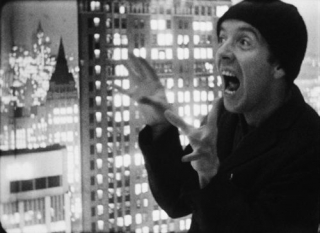Date: 8 November 1998 | Season: Underground America
RON RICE
Sunday 8 November 1998, at 7:00pm
London Lux Centre
After emerging as one of the major talents of the Underground, Ron Rice died in Acapulco in 1964. The four films he shot before his death show a unique vision. Jonas Mekas coined the term “Baudelairean Cinema” to describe the works of Ron Rice, Ken Jacobs, Bob Fleischner and Jack Smith. In The Queen Of Sheba Meets The Atom Man Rice further developed the style of his celebrated debut The Flower Thief. Both films star Taylor Mead as a wistful character who wanders through various picaresque episodes. He is joined in this humorous and uninhibited frolic by the huge (and frequently naked) Winifred Bryant and the legendary Jack Smith.
Ron Rice, The Queen of Sheba Meets the Atom Man, 1963, 109 min
PROGRAMME NOTES
RON RICE
Sunday 8 November 1998, at 7:00pm
London Lux Centre
Though he completed only four films in his lifetime, Ron Rice displayed a unique sensibility and attitude to cinema. His first film was The Flower Thief (1960), a feature length movie made in San Francisco. It starred Taylor Mead as a wistful character wandering through a series of improvised and playful sketches with a beatific grace. This innocent but anarchic fantasy, was lovingly filmed by Rice, who succeeded in liberating the camera from its previous restraints. Jonas Mekas hailed the film a classic of “The Baudelairean Cinema”, a term he developed to describe work of that period by Ron Rice, Jack Smith and Ken Jacobs. Loosely planning to make a film called The Dancing Master, Rice went ‘on the road’ and filmed a trip to visit an island that one of the actors in The Flower Thief had allegedly bought from the Mexican government. By the time that his party arrived, the original settlers had left due to a lack of fresh water, but some footage was shot there before Rice returned to his home in New York. Senseless (1962) is a poetic stream of images from the journey, either acted or just documented. With his next film The Queen Of Sheba Meets The Atom Man (1963), Rice again used Taylor Mead to make a kind of New York version of The Flower Thief, which Mead regards as his greatest performance. The structure is similar, but this time Taylor is joined by the self-styled Queen of Sheba, a colossal negress called Winifred Bryan who spends much of the film in a state of undress. There are also notable cameo appearances by Judith Malina, Julian Beck, Ed Sanders and Jack Smith. It was mainly improvised and a lot of footage was shot, but the film was never edited into a definitive form by Rice himself. He did assemble a rough cut for a benefit screening in 1963, but the next day he took off with the money and headed back to Mexico to make his home there. He returned briefly to New York and made Chumlum (1964). In contrast to his other films it is composed of dense layers of superimposition and appears as a bizarre dream. It was shot in the evenings after the cast of Jack Smith’s Normal Love (1963) had returned to the city after filming on location out of town. The cast consists of Smith’s superstars, with the addition of Gerard Malanga, and the soundtrack is performed by Angus MacLise on the cembalum. Rice returned to Mexico and lived a life of poverty, shooting a dozen rolls of film that were posthumously collected as The Mexican Footage (1964). He retained his unique vision and remained enthusiastic about future projects but died of bronchial pneumonia in Acapulco, December 1964, at the age of twenty nine. After his death, Howard Everngam assembled Queen Of Sheba to his best knowledge of the filmmakers intentions. This version was distributed until 1979, when Taylor Mead used his memories and notes of the shooting to prepare the definitive version of the film.
THE QUEEN OF SHEBA MEETS THE ATOM MAN
Ron Rice, USA, 1963, 16mm, b/w, sound, 109 min
“Broadly farcical with an Aristophanaic buoyancy, Sheba unwinds in interior scenes in which Taylor Mead and the more or less undressed Winifred Bryan are grotesquely displayed in cacophonous tableaux of total disarray, enmeshed in furniture, props, and costumes, with a stuffed bear and the junk strewn across their bodies in chaotically unstructured compositions. The point of departure for these comic scenes is the unusual physical characteristics of Mead and Bryan and their incongruous relationship: the puny, rubbery, and totally uncoordinated Atom Man is simultaneously drawn to and intimidated by the massive bulk and voracious appetites of the African Queen. In her strolls through the city parks and especially in a sequence in which she takes a ferry ride in dense fog, Bryan establishes for herself a strong and plangent dignity; but in the interiors she is an almost amorphous mass of flowing flesh which fills or engulfs whatever it encounters, capable not really of shifting but only of being redistributed in more and more grotesque shapes.” (David E. James, from his book Allegories Of Cinema: American Film In The Sixties, 1989)
“This is a wildman rough cut like no Hollywood director would dare show the public for fear of having his ideas stolen. We defy anyone to cop our style. This is only 70 minutes of a protracted 3 hour epic by the director of The Flower Thief. This is your opportunity to help challenge the Hollywood stranglehold on morals, expression, and art and what have you. Dig us.” (Ron Rice, mimeographed note for the benefit screening of The Queen Of Sheba Meets The Atom Man, 1963)
Back to top
